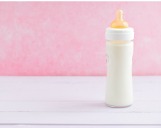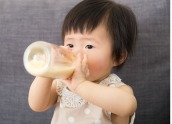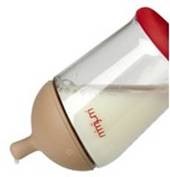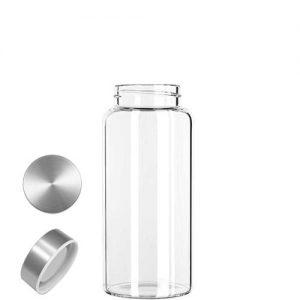 If you breastfeed and never plan to use a pump, congrats! You won’t need to worry about picking out just the right baby bottle because–tag—you’re it! You’ve got two boob-bottles ready to go, thanks to Mother Nature. But if you pump or use infant formula at least some of the time, bonafide baby bottles are a must, of course.
If you breastfeed and never plan to use a pump, congrats! You won’t need to worry about picking out just the right baby bottle because–tag—you’re it! You’ve got two boob-bottles ready to go, thanks to Mother Nature. But if you pump or use infant formula at least some of the time, bonafide baby bottles are a must, of course.
In the bottle aisle, your options include plastic, glass, stainless steel and silicone. Which baby bottle is best? To answer that question, read on.
Plastic bottles: What is “EA-free”?
Plastic baby bottles dominate the market, so we’ll start there. They’re typically the best deal. You can buy an 8-ounce plastic baby bottle for around $4. Pros: Plastic BPA-free baby bottles can be relatively inexpensive, lightweight and virtually indestructible.
As you may know, all plastic baby bottles (and sippy cups) sold in the U.S. must be free of BPA, an endocrine-distrupting chemical in plastic that can leach into breast milk, formula and other beverages and into your baby. Structurally, BPA is so similar to natural estrogen that, like a knock-off pair of sunglasses, it can fake the body out. A synthetic chemical like BPA can mimic or block actions of natural estrogens in the body and disrupt the body’s endocrine system, which regulates the body’s hormones.
BPA and other endocrine-disrupting chemicals (there are more than 100) can bind to estrogen receptors on cells and interfere with normal hormone activity to potentially affect your baby’s health.
The studies are still rolling in but so far, BPA has been linked to thyroid and prostate cancer, obesity, diabetes, heart arrhythmias (fluttering), ADHD and autism.
“Developing fetuses and children early in life are susceptible to very low doses of endocrine-disrupting chemicals,” says Deborah Kurrasch, PhD, of the Kurrasch Lab in the department of medical genetics at the Alberta Children’s Hospital Research Institute. “But as we get older, it’s less of a concern.”
Should you just buy a BPA-free plastic baby bottle and call it a day? Nuh uh. Not so fast.
Swapping BPA for BPS
 BPA is no longer in plastic baby bottles (and sippy cups) sold in the U.S, (Whew!). But we’re not out of the woods, Dr. Kurrasch says. That’s because baby bottle manufacturers can legally substitute other endocrine-disrupting chemicals for BPA, including BPA’s close cousin, bisphenol S (BPS).
BPA is no longer in plastic baby bottles (and sippy cups) sold in the U.S, (Whew!). But we’re not out of the woods, Dr. Kurrasch says. That’s because baby bottle manufacturers can legally substitute other endocrine-disrupting chemicals for BPA, including BPA’s close cousin, bisphenol S (BPS).
And guess what? BPS is also an endocrine disrupter. A recent study in Environmental Health Perspectives found BPS to be as hormonally disruptive as BPA.
Another study, this one in Environmental Health, which tested BPA-free plastic baby bottles, found that most of the BPA-free bottles tested leached endocrine-disrupting chemicals. All told, “BPA-free doesn’t mean BPS-free or endocrine-disrupting free,” Dr. Kurrasch says.
Bottomline: BPA-free bottles can release chemicals, such as BPS, which act like estrogen in the body. Both male and female babies produce estrogen. It plays a critical role in the development of the brain, mammary glands and testes.
Better Plastic Baby Bottle Brands
Fortunately, there’s a brand of plastic bottle on the market that’s been quietly estrogenic activity free: Mimijumi.  Manufactured in Austria, Mimijumi bottles are made from Swiss polyamide plastic to ensure a toxin free feeding experience without BPA, lead or other contaminants. Mimijumi representatives confirmed that Mimijumi bottles are free of 564 EA-causing chemicals, as per European standards.
Manufactured in Austria, Mimijumi bottles are made from Swiss polyamide plastic to ensure a toxin free feeding experience without BPA, lead or other contaminants. Mimijumi representatives confirmed that Mimijumi bottles are free of 564 EA-causing chemicals, as per European standards.
To avoid bottles with EA, try Mimijumi bottles. Here’s what you else you can to do to buy a bottle that doesn’t leach chemicals with hormonal activity—or that leaches as little as possible.
-
Go with Glass Baby Bottles
Dr. Kurrash recommends using glass baby bottles. “Glass is best because there is nothing to leach,” she says. More pluses: Glass isn’t porous so it doesn’t give off an odor and won’t affect flavor. Glass baby bottles are 100 percent recyclable. But glass baby bottles aren’t perfect.
Glass–Cons:
Gripability. Glass bottles are heavier for you and your baby to hold than plastic, stainless steel and silicone bottles are. Consider: A plastic BornFree Eco Deco (green) 9-ounce bottle weighs just 2.4 ounces. A Klean Kanteen 9 oz stainless steel bottles weighs in at 5.6 ounces as does an 8 oz Comotomo Natural Feel (silicone) baby bottle. A glass (wide neck) BornFree 9-ounce bottle weighs in at 10.4 ounces, which is more than two iPhone 6s combined. For your baby, that’s a mini workout. A 4-ounce bottle is lighter, of course.
Durability. Glass baby bottles can last from baby to baby, unless, of course, the glass bottle breaks. Fortunately, there’s a silicone protective sleeve for most types of glass baby bottles that helps you and your baby grip the bottle. It can make a fun style statement too.
Note: At least two brands of glass baby bottles, Philips Avent and LifeFactory, use pharmacy-grade glass for their glass baby bottles. That means, if you drop those bottles, the glass shatters within itself.
Glass Baby Bottle Options
Glass is a niche category. Still, several baby bottle manufacturers make a glass version of their bottle.
-
Pick a baby bottle with healthier plastic
Besides Mimijumi bottles, which feature plastic that’s free of estrogenic activity (EA), other plastics that look promising include:
Polyethersulphone (PES). One study, in Food Additives & Contaminants, found that PES plastic baby bottles released a low amount of migrating chemicals. Keep in mind, however, that that’s no guarantee that a PES bottle you buy won’t release EA chemicals because additives with EA may be used in manufacturing. But a PES bottle may at least reduce the overall amount of endocrine-disrupting chemicals your baby is exposed to.
Examples of Bottles Made from PES Plastic:
[easyazon_table attributes=”ListPrice” cloak=”n” identifiers=”B004I02JUW,B0044QAN4O,B00B202G72,B001IDPED6,B01CVOK3PY,B00IN6Y0PY” locale=”US” orientation=”at” tag=”babyprodu0369-20″ text=”Green to Grow Mellow Colic-Relief Wide Neck Baby Bottle, 5 Ounce|Mebby 250Ml Gentle Feed Bpa Free Pes Baby Bottle -Orange And Honey|Dele Wide Neck PES Feeding Bottle with Handle Baby Bottle 270ml Dl1211|Zoli Baby PES BPA-free Baby Bottle with Anti Colic Nipples – 10 oz – 2 Pk (EOL)|Basilic BPA Free PES Anti Colic Wide Neck Feeding Bottle, 11 Ounce (pack of 2)|In PES Medel Mebby Bottle Step 1 + 2 Anticolic With Teat Latex 180ml”]
It’s also possible to make baby bottles from three other types of plastic: cyclic olefin copolymer (COC), cycle olefin polymer (COP) or glycol-modified polyethylene terephthalate (PETG), using resins and other additives that are free of detectable EA.
There’s a good chance that lots of plastic baby bottles are on the market right now that are EA-free (besides Mimijumi), but their manufacturers don’t realize it because they haven’t tested them for estrogenic activity.
3. Try a Stainless Steel Bottle
Stainless steel baby bottles are another option. Stainless steel is safe to use/free of EA because it’s not plastic.
Cons: But because stainless steel is opaque, you can’t see how much formula or breast milk is in a stainless steel bottle. Another potential downside: Some parents attest that stainless steel can affect the taste of breast milk or formula.
What About Silicone Bottles?
Silicone baby bottles are made from silica, a component of sand, and silicone is EA-free. Like plastic, silicone baby bottles are virtually unbreakable. Still, George D. Bittner, Ph.D., a professor of neurobiology at the University of Texas-Austin and an environmental researcher cautions against silicone. “In our tests, silicone is more problematic than plastic not because of the silicone itself, but the additives. Silicone bottles glow in the dark,” he says. In one study, a silicone baby bottle that was tested released a high amount of migrating compounds, some of which weren’t approved by the European Union for contact with food.
What does this all boil down to?
Here’s a recap:
–BPA-free means a baby bottle is free of one endocrine-disrupting chemical, BPA, which has been the most studied.
–BPA-free plastic bottles can give off other chemicals, such as BPS, which can mess with your baby’s estrogen and other hormone levels.
–Prediction: EA-free bottles will be the new BPA-free. Manufacturers will join Mimijumi and get on the EA-free bandwagon, especially if consumers demand it.
Until then, to avoid hormone-disrupting chemicals, try a glass, stainless steel bottle, potentially healthier plastic or EA-free baby bottles.
There’s one baby plastic baby bottle that’s EA-free right now, for sure: Mimijumi.
Basic Bottles Dos and Don’ts
There’s so much more to say about this topic. But I’m going to end this marathon post with some basic EA-free(ish) baby bottle dos and don’ts, to keep endocrine-disrupting chemicals at a minimum:
DON’T–use soap. No matter which type of bottle you choose, it’s possible that the dishwashing detergent you use to clean baby bottles can leave a residue that has EA. To avoid EA, wash glass bottles in hot water but without soap, Dr. Bittner advises. But go ahead wash by hand, in the top rack of the dishwasher or boiled (but boiling isn’t necessary).
DO—let your baby is the judge. The bottle you choose is important, but sometimes it’s the nipple that makes the difference to your baby. Experiment with a glass, stainless or EA-free(ish) nipple/bottle combo until you find one your baby likes. Even Mimijumi admits on their home page that “97% of babies love our bottles.” That means 3 percent prefer something else.
DO—throw out all plastic baby bottles that are scratched or damaged ASAP, even those that are EA-free. An intact plastic baby bottle isn’t the same as one that’s worn or scratched. Germs can set up shop in the tiny crevices to potentially infect your baby. Ruffed up plastic can release EA chemicals too.
DON’T—leave your baby bottle out in the sun or in your car in the sun (you get the idea). Ultraviolet light from the sun can cause plastic to breakdown and leach chemicals with EA. This goes for any plastic baby bottle, including the Mimijumi.
DO–cut down on your own plastic use, especially if you’re pregnant or breastfeeding. Endocrine-disrupting chemicals like BPS can cross the placenta to your baby and migrate into breast milk.
“Mom should be more careful about what she’s exposed to and what baby is exposed to,” Dr. Kurrasch says. In addition to baby bottles, food containers can leach chemicals having EA. In her own house, Dr. Kurrasch keeps everything in glass. Store food, including baby food, in glass rather than plastic containers. Dr. Kurrasch makes her kids take glass water bottles to soccer practice too.
 There are lots of glass water bottles on the market, but water bottles made with borosilicate glass, such as the Kablo glass water bottle, are preferred because they’re more durable. Here’s more about what is borosilicate glass and why it’s better.
There are lots of glass water bottles on the market, but water bottles made with borosilicate glass, such as the Kablo glass water bottle, are preferred because they’re more durable. Here’s more about what is borosilicate glass and why it’s better.
Borosilicate glass is made from 15 percent boron trioxide, which is a magical ingredient that makes glass resistant to cracking under extreme temperature changes, such as going from freezer to hot water at the faucet, like regular glass can. Boron trioxide won’t leach into food and beverages. (Kablo first-timers get 10% off their first purchase.)
Never miss a post!
If you haven’t already, be sure to sign up to receive Babyproductsmom posts and special offers by e-mail. Enter your e-mail in the blinking box–to your right, if you’re on your desktop or scroll down if you’re on your phone, and you’re in!
Copyright Sandra Gordon Writing Resources LLC
Updated May 2018
Related Posts
Reader Interactions
QUESTIONS? COMMENTS? GO AHEAD–OUT WITH IT!








[…] to good start. (Money saver: Skip 4-oz bottles. Babies don’t use them for long.) Check out this post for your healthiest bottle options. Also popular: Playtex Nurser with Drop-in Liners. Use 8 oz […]